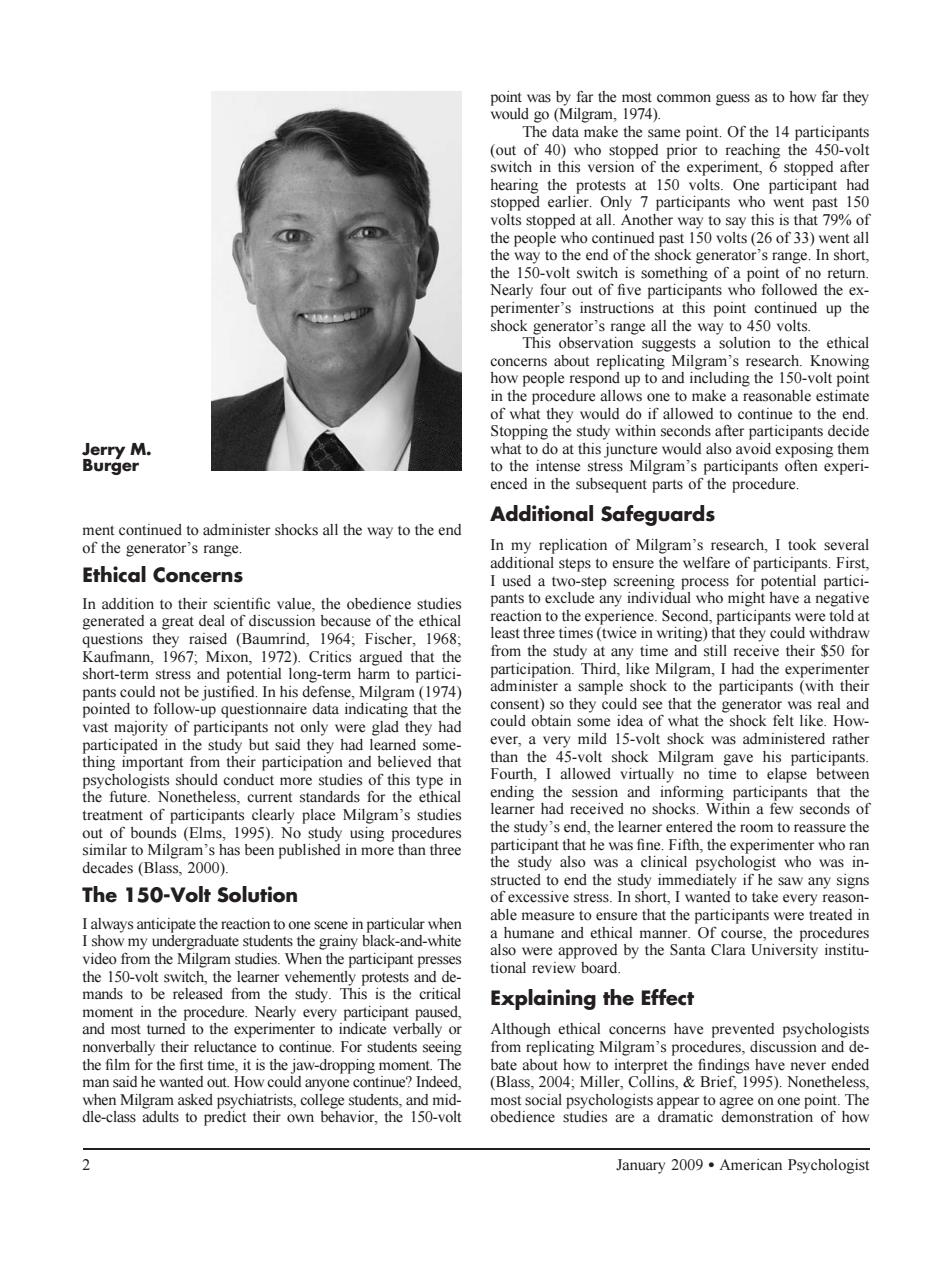正在加载图片...

t common guess as to how far they (o vol 150 volts.One went past 150 ck generator's range.In short. enter's instructions the u to nd the 150-vot pon Burger exper enced in the subsequent parts of the procedure. Additional Safeguards research,I took severa Ethical Concerns used a twe ocess for In addition to their scientific value the obedience studie pants to ex ave a negati )Critics oued that the tion Third.like Milgr Ihad the sample ck to pointed to followup questionnaire data indicating that the very mild rath treatment of participants arly place Milgram's studies the study's end,the learner en tered the room to reassure the sima ileram's has been published in more than three decades(Blass.2000) The 150-Volt Solution saw any sign ble measure to ensure that the r Ialways anticipate the wher vide from the Milgram studies whenhe wh rticipant tional review board. s the ment in the procedure.Nearly ever Explaining the Effect rbally or the film for the first time.it is the jaw-dropping moment.The bate about hov the finding ave never ended (Blass,2 Collins,&Brief, obedience stdies are dramatic emonstration of how January 2009American Psychologistment continued to administer shocks all the way to the end of the generator’s range. Ethical Concerns In addition to their scientific value, the obedience studies generated a great deal of discussion because of the ethical questions they raised (Baumrind, 1964; Fischer, 1968; Kaufmann, 1967; Mixon, 1972). Critics argued that the short-term stress and potential long-term harm to participants could not be justified. In his defense, Milgram (1974) pointed to follow-up questionnaire data indicating that the vast majority of participants not only were glad they had participated in the study but said they had learned something important from their participation and believed that psychologists should conduct more studies of this type in the future. Nonetheless, current standards for the ethical treatment of participants clearly place Milgram’s studies out of bounds (Elms, 1995). No study using procedures similar to Milgram’s has been published in more than three decades (Blass, 2000). The 150-Volt Solution I always anticipate the reaction to one scene in particular when I show my undergraduate students the grainy black-and-white video from the Milgram studies. When the participant presses the 150-volt switch, the learner vehemently protests and demands to be released from the study. This is the critical moment in the procedure. Nearly every participant paused, and most turned to the experimenter to indicate verbally or nonverbally their reluctance to continue. For students seeing the film for the first time, it is the jaw-dropping moment. The man said he wanted out. How could anyone continue? Indeed, when Milgram asked psychiatrists, college students, and middle-class adults to predict their own behavior, the 150-volt point was by far the most common guess as to how far they would go (Milgram, 1974). The data make the same point. Of the 14 participants (out of 40) who stopped prior to reaching the 450-volt switch in this version of the experiment, 6 stopped after hearing the protests at 150 volts. One participant had stopped earlier. Only 7 participants who went past 150 volts stopped at all. Another way to say this is that 79% of the people who continued past 150 volts (26 of 33) went all the way to the end of the shock generator’s range. In short, the 150-volt switch is something of a point of no return. Nearly four out of five participants who followed the experimenter’s instructions at this point continued up the shock generator’s range all the way to 450 volts. This observation suggests a solution to the ethical concerns about replicating Milgram’s research. Knowing how people respond up to and including the 150-volt point in the procedure allows one to make a reasonable estimate of what they would do if allowed to continue to the end. Stopping the study within seconds after participants decide what to do at this juncture would also avoid exposing them to the intense stress Milgram’s participants often experienced in the subsequent parts of the procedure. Additional Safeguards In my replication of Milgram’s research, I took several additional steps to ensure the welfare of participants. First, I used a two-step screening process for potential participants to exclude any individual who might have a negative reaction to the experience. Second, participants were told at least three times (twice in writing) that they could withdraw from the study at any time and still receive their $50 for participation. Third, like Milgram, I had the experimenter administer a sample shock to the participants (with their consent) so they could see that the generator was real and could obtain some idea of what the shock felt like. However, a very mild 15-volt shock was administered rather than the 45-volt shock Milgram gave his participants. Fourth, I allowed virtually no time to elapse between ending the session and informing participants that the learner had received no shocks. Within a few seconds of the study’s end, the learner entered the room to reassure the participant that he was fine. Fifth, the experimenter who ran the study also was a clinical psychologist who was instructed to end the study immediately if he saw any signs of excessive stress. In short, I wanted to take every reasonable measure to ensure that the participants were treated in a humane and ethical manner. Of course, the procedures also were approved by the Santa Clara University institutional review board. Explaining the Effect Although ethical concerns have prevented psychologists from replicating Milgram’s procedures, discussion and debate about how to interpret the findings have never ended (Blass, 2004; Miller, Collins, & Brief, 1995). Nonetheless, most social psychologists appear to agree on one point. The obedience studies are a dramatic demonstration of how Jerry M. Burger 2 January 2009 ● American Psychologist